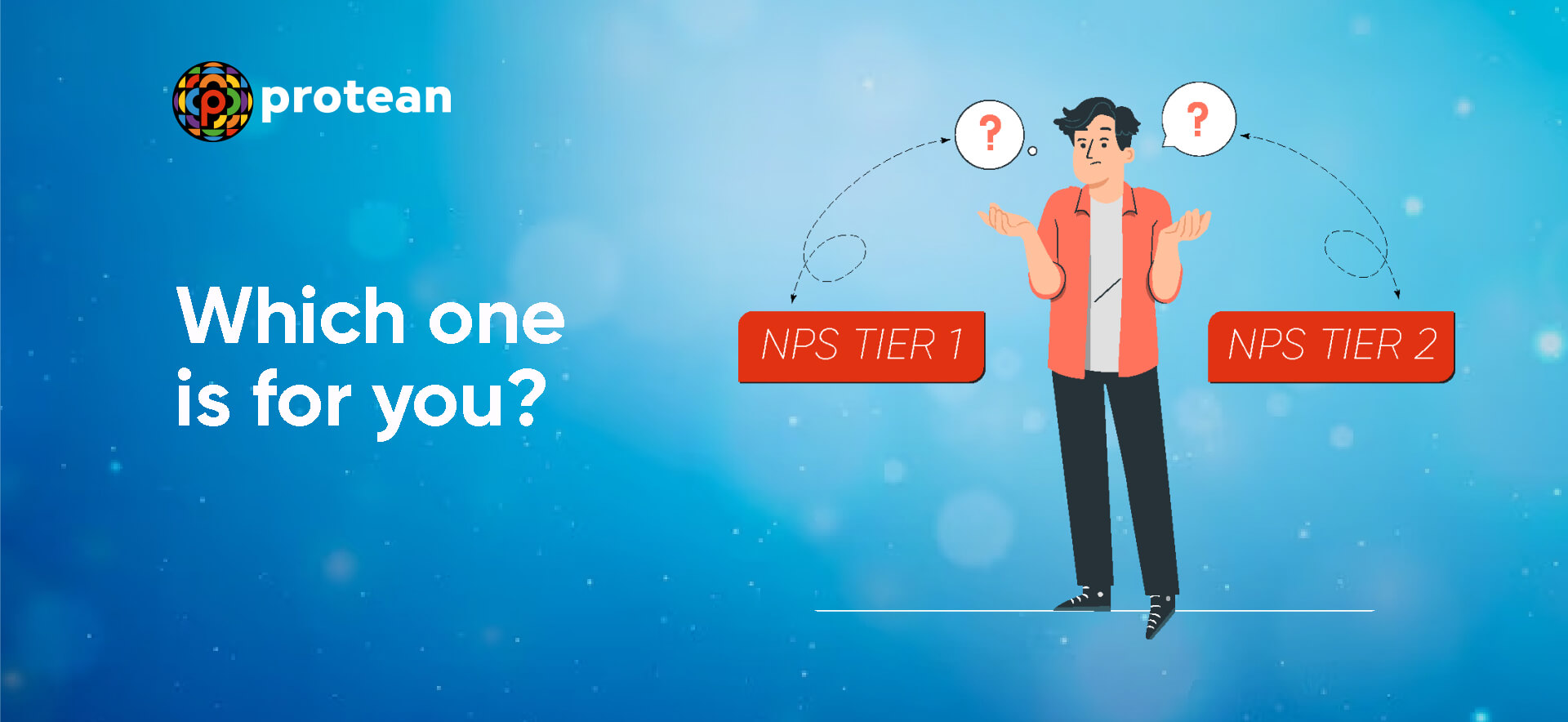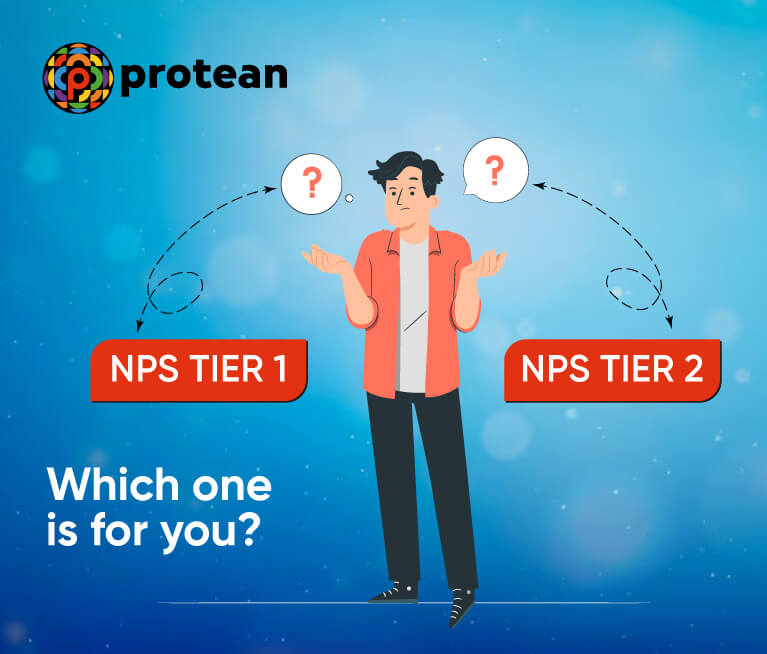While retirement planning may not seem important while you are young, it’s an essential step towards financial freedom. The National Pension System (NPS) provides an easy way to grow your wealth for retirement while enjoying various tax benefits.
NPS was introduced in 2004 by the Pension Fund Regulatory and Development Authority (PFRDA) under the Government of India. It is a market-linked and voluntary contribution scheme providing retirement benefits to any Indian citizen. All assets under the scheme are held by the NPS Trust.
In this blog, we will explore the details of the two types of NPS accounts. Read along to know which one is more suitable for you.
What Is NPS Tier 1?
An NPS Tier 1 account is the basic NPS account. If you wish to subscribe to NPS, you have to mandatorily open a Tier 1 account. It is a long-term investment account meant for retirement planning through market-linked returns. You must invest at least ₹500 to open a Tier 1 account and at least ₹1000 per financial year to maintain it.
The salient features of a Tier 1 account of the National Pension Scheme are:
- You can keep contributing till you are 60 years of age. After the account matures, you can extend the maturity date by 10 more years, i.e. you can remain invested till the age of 70 years.
- You can open only one NPS Tier 1 account in your name.
- An important feature of this account is that you can earn tax deductions under Section 80 CCD for investments in an NPS Tier 1 account.
- You can withdraw funds partially from a Tier 1 account to fulfil certain urgent requirements such as medical emergencies, education expenses, marriage costs, etc.
- You can close the account prematurely only if you fulfil certain terms and conditions.
Eligibility to Open an NPS Tier 1 Account
You have to be a resident or non-resident Indian between the ages of 18 and 70 years to open an NPS Tier 1 account. But, if your citizenship status as an NRI changes, your NPS account will be closed. Persons of Indian Origin (PIO) are not eligible to open an NPS account. Hindu Undivided Families (HUF) are also not eligible. Corporate bodies can register for NPS and offer the retirement scheme to their employees.
The minimum amount required to open an NPS Tier 1 account is ₹500. The minimum contribution in a year must be ₹1000.
Documents Required to Open NPS Tier 1 Account
You need to mandatorily submit documents for KYC compliance before opening an NPS Tier 1 account. Here are some of the required documents:
- NPS account opening form
- Registration form
- Aadhaar card
- Proof of identity
- Proof of address
- Age or D.O.B proof
NPS Tier 1 Withdrawal and Premature Closure
Check the withdrawal and premature closure details below:
- After maturity, investors can withdraw a lump sum of up to 60% of the entire accumulated corpus. The rest of the corpus is used to buy an annuity plan.
- You can withdraw a maximum of 25% of the total contributions to NPS before maturity.
- Throughout the investment period, you can make at most 3 withdrawals.
- Don't forget that you can only make partial withdrawals after staying invested for 3 years.
- You will have to provide a valid reason for withdrawing funds. Withdrawals are allowed only for specified reasons.
Benefits of NPS Tier 1
Listed below are the benefits of having an NPS Tier 1 account:
• Tax Deductions on Tier 1 contributions
Contribution up to ₹1,50,000 in an NPS Tier 1 account is eligible for tax deductions under Section 80CCD (1) of the Income Tax Act, 1961.
As per Section 80CCD(2), salaried individuals can claim their employer’s contributions as additional tax deductions. The limit is set to 14% of one’s salary for government employees. People working in the private sector can claim up to 10% of their salary, including basic and dearness allowance, under Section 80CCD(2) of the ITA.
According to 80CCD(1B) of ITA, you can claim self-contributions up to a maximum of ₹50,000 as a tax deduction over and above the limit of Section 80CCD (1).
• Partial withdrawals are tax-exempt
You can make partial withdrawals after only 3 years of investment citing valid reasons, as already mentioned above. Such NPS withdrawals are entirely tax-exempt under Section 10 (12B).
• Returns are tax-exempt till maturity
A significant benefit of an NPS Tier 1 account is that lump sum returns you receive after maturity is tax-exempt. Tax-free withdrawals are limited to 60% of the total invested corpus.
• Tax benefits upon maturity
Upon turning 60 years, you can withdraw 60% of the corpus as a lump sum. You can use the remaining 40% to buy annuities. Both of these are entirely tax-exempt.
Suppose, a 60-year-old man has a total of ₹30,00,000 in an NPS Tier 1 account. He can withdraw ₹18,00,000, i.e. 60% of the total amount as a lump sum. He can use the remaining ₹12,00,000 to buy annuities. However, his monthly pension is subject to taxation.
What Is NPS Tier 2?
NPS Tier 2 account is an add-on account which you can open only if you have an NPS Tier 1 account. It offers more flexibility than a Tier 1 account allowing you to make withdrawals as and when required. Check its salient features below:
- While ₹1000 is the minimum amount required to open this account, you don't have to maintain a minimum annual financial contribution. This is a major point of difference with the NPS Tier 1 account. Moreover, there's no maximum limit for contributions to this account.
- There is an important factor you need to take into account—contributions to the NPS Tier 2 account must be in multiples of 250.
- You will be able to enjoy greater withdrawal flexibility with zero exit charges.
Eligibility Criteria to Open NPS Tier 2 Accounts
You need to be a resident Indian between the ages of 18 years and 70 years with an NPS Tier 1 account. A Permanent Retirement Account Number (PRAN) is a must-have to open a Tier 2 account. Once you open a Tier 2 account with ₹1000, your contributions to the account must be in the multiples of ₹250.
Documents Required to Open an NPS Tier 2 Account
Keep these documents ready to open an NPS Tier 2 account:
- Proof of identity
- Proof of residential address
- Duly filled registration form
- Age proof or DOB certificate
Benefits of NPS Tier 2
Check the benefits of an NPS Tier 2 account:
• Faster and Feasible
You can open an NPS Tier 2 account easily as the procedure involved is quite simple. An NPS Tier 2 account can be opened from anywhere and at any time.
• Decision Rests Entirely with the Subscriber
The decision to open an NPS Tier 2 account rests entirely with you. You can open this account if you want to contribute a larger amount to an account with no restrictions. There are also no minimum requirements for contributions that you have to make annually.
• Flexibility with Easy Withdrawals
You can withdraw funds easily from NPS Tier 2 accounts to address financial emergencies. The fact that there is no exit load is a significant benefit.
• Easy Transfer of Funds
Transfer funds from NPS Tier 2 account to the Tier 1 account at your convenience. There are no upper or lower limits on the amounts that can be transferred. The procedure to invest in Tier 2 is the same as that of Tier 1.
Differences between NPS Tier 1 and NPS Tier 2
The following table presents the differences between NPS Tier 1 and NPS Tier 2 accounts:
| NPS Tier 1 | NPS Tier 2 |
| Indian citizens aged between 18 years and 70 years are eligible to open it. | Indian citizens who hold an NPS Tier 1 account are eligible to open an NPS Tier 2 account. |
| Contributions to NPS Tier 1 account remain locked till the account holder attains 60 years. Partial withdrawals upon valid reasons can be made only after 3 years from the initial date of investment. | These don’t have any lock-in periods. NPS Tier 2 is a voluntary add-on account which allows flexible withdrawals and exits. |
| You can avail various tax deductions for contributions made to an NPS Tier 1 account. | You can avail various tax deductions for contributions made to an NPS Tier 1 account. |
| You can transfer funds from an NPS Tier 2 account or EPF (Employees Provident Fund) to NPS Tier 1 account. | You cannot transfer funds from an NPS Tier 1 account to a Tier 2 account. |
Which One Should You Choose - NPS Tier 1 or NPS Tier 2?
The NPS Tier 1 account is the basic account which you must have if you wish to subscribe to the National Pension Scheme in India. The NPS Tier 2 account is a voluntary add-on account which you can open if you have an NPS Tier 1 account.
The decision to open a Tier 2 account depends solely on your financial requirements. If you feel that you need to withdraw funds frequently, you can consider opening a Tier 2 account because it does not carry any stringent rules regarding withdrawals.
Asset Classes
While investing in NPS, you must also decide on the types of assets you want to invest in and determine the proportion of your investment for each category. There are four asset classes available under a single Pension Fund Manager:
Asset Class E: Includes equities and related investments.
Asset Class C: Comprises corporate debt and related instruments.
Asset Class G: Consists of government bonds and related investments.
Asset Class A: Encompasses alternative investment funds such as CMBS, MBS, REITS, AIFs, Invlts, etc.
When selecting asset classes, keep in mind:
Alternative Investment Funds cannot exceed 5% of the total allocation.
The combined allocation across all asset classes (E, C, G, and A) should add up to 100%.
Tier-II allows 100% allocation to Equity.
Tier-I permits allocating up to 75% to Equity.
Investment Options
Investors in the NPS have two avenues to decide how their assets are allocated across different classes. They can either follow a preset allocation pattern or customize the ratios themselves. The former approach is referred to as 'auto' choice, whereas the latter is termed 'active' choice.
Auto Choice: Offers a convenient option to invest in a Life-cycle fund, where the distribution of funds across asset classes is predetermined and adjusts according to your age. With Auto Choice, as you grow older, your exposure to Equity and Corporate Debt typically decreases. Depending on your risk tolerance, there are three variations available within Auto Choice – Aggressive, Moderate, and Conservative.
Active Choice: Allows you to actively plan and select your investment preferences, including the choice of Pension Fund Manager, scheme(s), and percentage allocation across asset classes.
Final Words
To sum up, there are two types of accounts you can hold with NPS Trust—Tier 1 and Tier 2. While the former is a basic account which all NPS subscribers have, the latter is an additional and voluntary account which you can choose to open for additional savings.
Check your financial habits and plans before making a decision. If you need to withdraw funds frequently, you can open a Tier 2 account while paying only the minimum contribution to the Tier-1 account. If a retirement plan is your only goal, you may not need a Tier 2 account.
Frequently Asked Questions
1. Who can join NPS?
Any Indian citizen aged 18 to 70 years can start investing in NPS from the official website of Protean. People can join NPS individually or as a part of an employer benefit. PIOs (Persons of Indian Origins) and HUFs (Hindu Undivided Families) cannot register themselves under NPS. However, Overseas Citizens of India (OCIs) can join and subscribe to the NPS.
2. Is NPS available for private sector employees?
Yes, private sector employees can open both NPS Tier 1 and Tier 2 accounts. They can claim up to 10% of their salary as a deduction over and above the limits of Section 80CCD (1). As per Section 80CCD (2) of the IT Act, salaried individuals can claim their employer’s contributions as additional tax deductions. People working in the private sector can claim up to 10% of their salary, including basic and dearness allowance, under Section 80CCD (2) of the IT Act.
3. How many nominees can be appointed for NPS Tier 1 and Tier 2 accounts?
You can appoint a total of 3 nominees for both NPS Tier 1 and Tier 2 accounts. While opening an NPS account, you need to fill up the designated section of a registration form and provide details of your nominee.
4. What are the investment choices available in NPS?
NPS offers two investment choices—active choice and auto choice/lifecycle fund. Active choice helps the investor decide how much money should be invested in different assets. The second option is a default or automated option which changes the portfolio with the age of the subscriber.
5. What document can I use as investment proof to avail of tax benefits?
If you’re an NPS subscriber, you can use the printout of the Transaction Statement as a valid document for claiming tax benefits.


